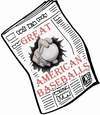|
Cleveland Stadium Cleveland Stadium opened to Indian fans on July 3, 1932. Located at 1085 West 3rd Street, it's original cost was a staggering $2 1/2 million. A huge amount for the time. It's original seating capacity was an incredible 78,000. The reason for the large number of seats was because the ball park was actually a pre-cursor to some of today's sports stadiums. It was built for both baseball and football. The Browns of the NFL would use the stadium from 1946 until 1995. Another early innovation was the use of structural aluminum for it's construction. Nearly every other new baseball stadium of it's time was built from steel and concrete. Cleveland Stadium was known by several other names through out the years. Lake Front Stadium, Municipal Stadium and even "The Mistake By The Lake". It replaced the Indians former home, League Park. When the Indians moved in for the 1932 season, they played only night games and weekend games at their new baseball stadium. Their "during the week" day games were still played at League Park which didn't have lights. Cleveland Stadium was so huge that an inner fence was constructed in 1947 to reduce the size of the field. No player ever hit a home run to center field which originally stood at 480 feet. Cleveland Indians owner Bill Veeck was constantly moving the fence in and out, to favor the Indians. The American League eventually made a rule that dis-allowed baseball clubs from moving the fences after the season had started. Cleveland Stadium was built close to Lake Erie. This provided for frigid winds in the spring and summer and miserably hot summer nights which drew swarms of mosquitos and other various bugs. As the 1980s came to a close it became apparent that Cleveland Stadium was in structural decline. The "Gateway Project" was now under way, which planned to build a new baseball stadium for the Indians, and new arena for the Cleveland Cavaliers of the NBA and a new football stadium for the Browns. Cleveland Browns owner Art Modell refused to participate in the project. He didn't think his revenues would fall off by remaining at Cleveland Stadium. His assumptions proved wrong. When the Cleveland Indians moved out, total revenue for the Browns declined too. So in 1995, Modell moved his Browns to Baltimore. The Cleveland Indians left Cleveland Stadium for brand new Jacobs Field after the 1993 season. The wonderful old "Mistake By The Lake" was demolished in 1996. It was literally "buried at sea". The pieces of the wreckage were hauled to lake Erie and dumped in the water to form an artificial reef. The new Cleveland Browns stadium now stands on the site. Cleveland Stadium Dimensions: Originally the stadium's double-decked grandstand extended well beyond the foul poles before giving way to uncovered bleachers, which were originally 463 feet from home plate in right and left-center fields. The distance was shortened considerably when the inner fence was added. The park's eventual dimensions were fairly average. The left and right field lines ran 322 feet. The power alleys in left and right center were at 385 feet. Center field was a "reacheable" 400 feet. Memorable Moments: In 1948, the Cleveland Indians set an attendance record by drawing 2.6 million fans. On September 12, 1954, the the largest crowd in American League history watched the Indians and the New York Yankees. 84.587 fans attended the game. On June 17, 1960, Boston Red Sox outfielder Ted Williams hit his 500th home run at Cleveland Stadium, off of Wynn Hawkins. Behind the pitching of Bob Feller, the Cleveland Indians won the 1948 World Series. In 1949, after losing the pennant to the Yankees, the Cleveland Indians buried their 1948 championship flag in center field of Cleveland Stadium. The 1954 Indians won the American League pennant again, by winning a record 111 games, but were swept four straight in the World Series by the New York Giants. Cleveland Stadium hosted four Major League Baseball All Star games. 1935, 1954, 1963 and 1981. On October 3, 1993, the Indians played their last game at Cleveland Stadium. Bob Hope led fans by singing "Thanks For The Memories".
|



 Sign Up For My Free Newsletter!
Sign Up For My Free Newsletter!